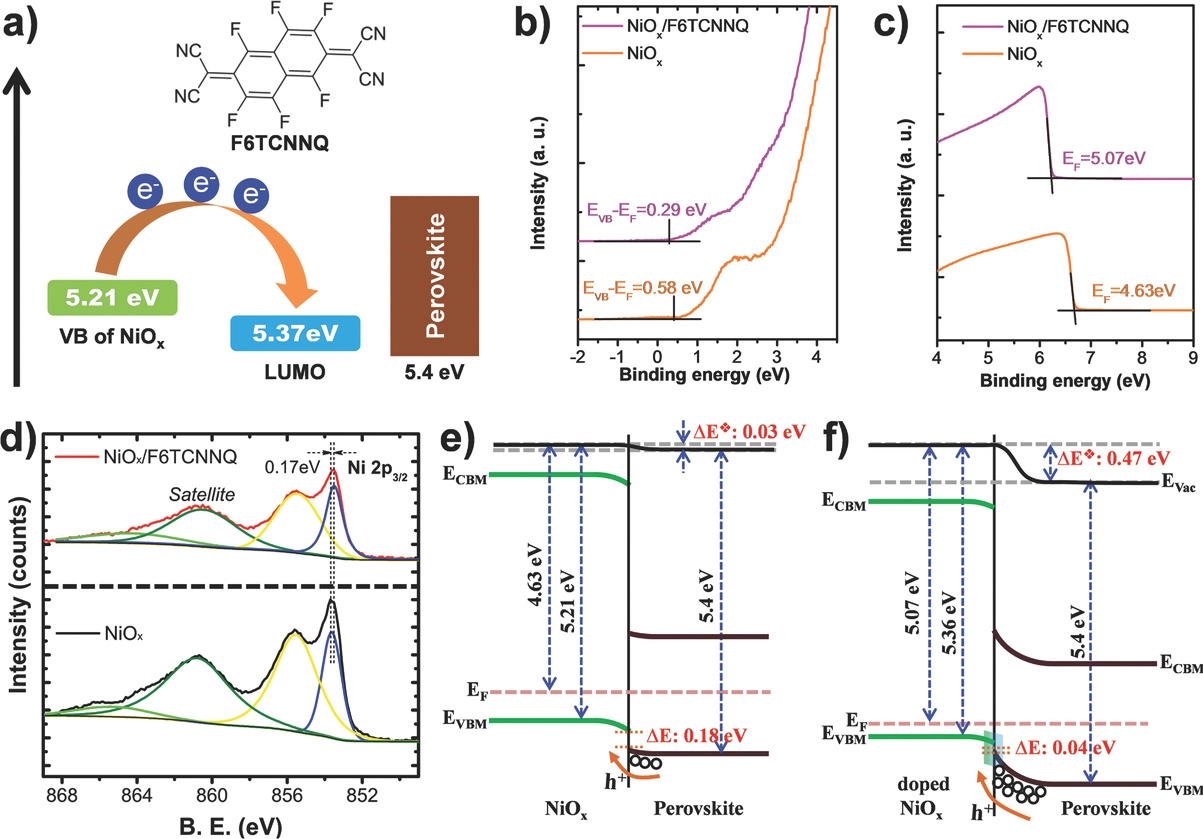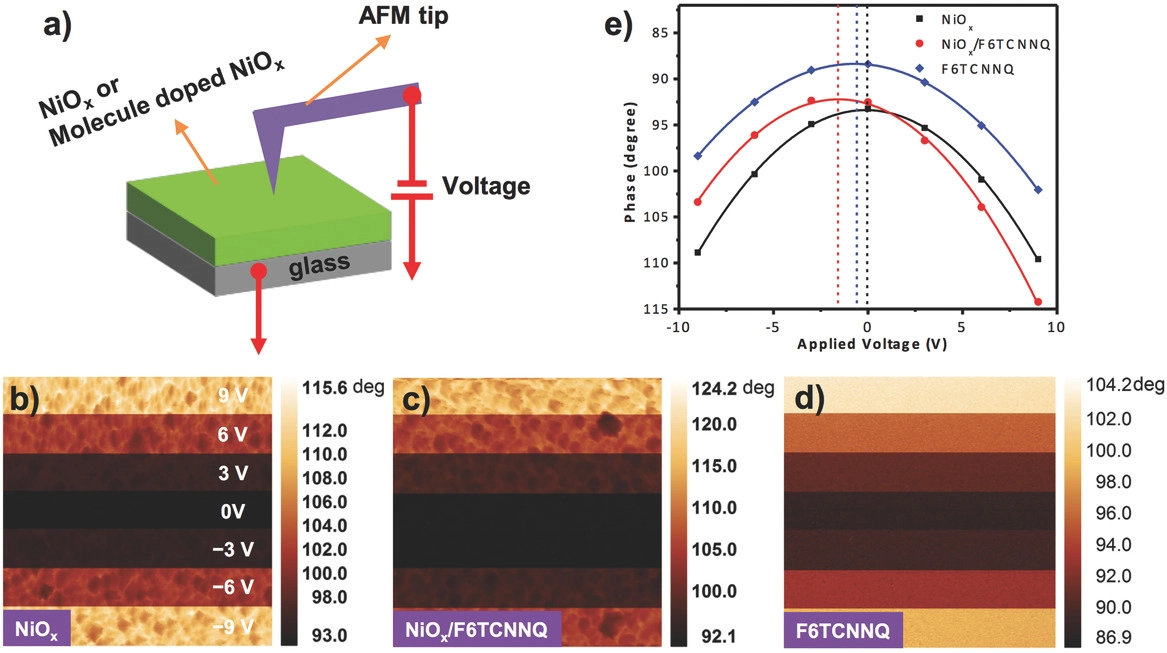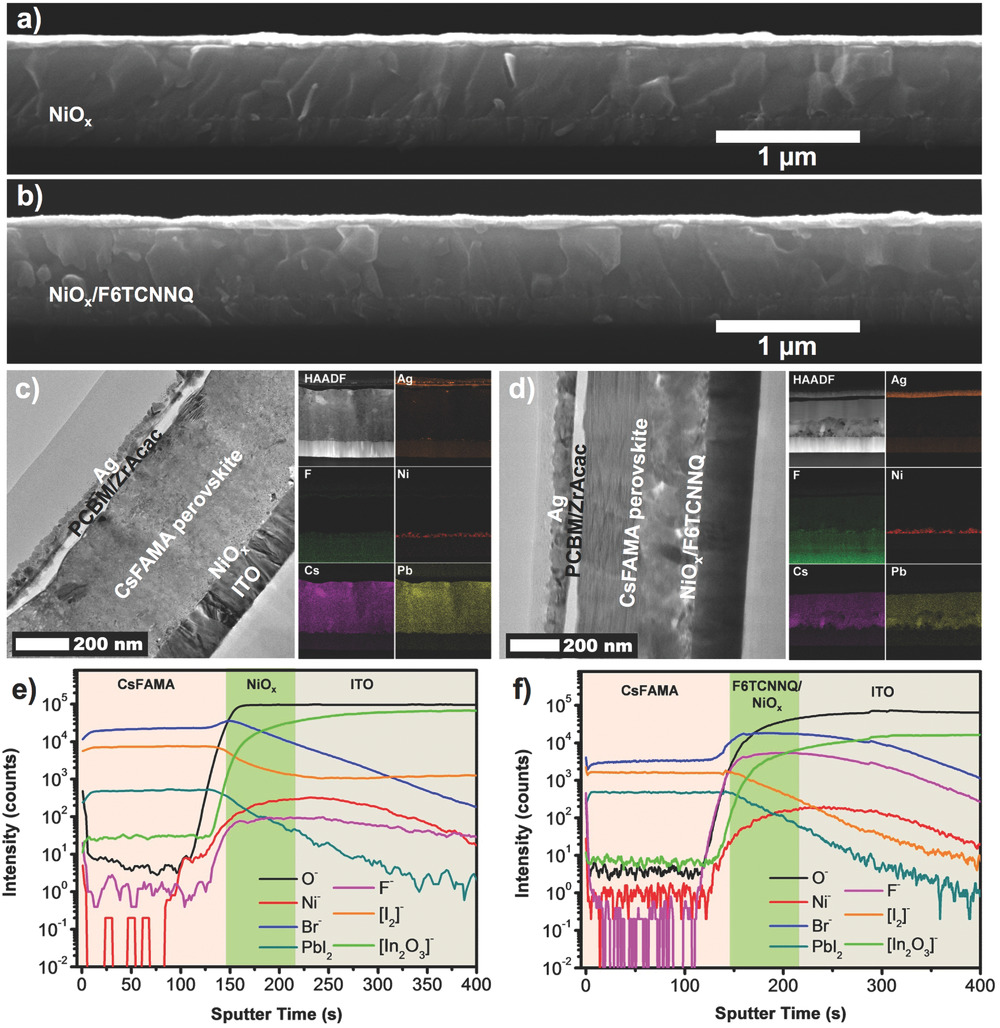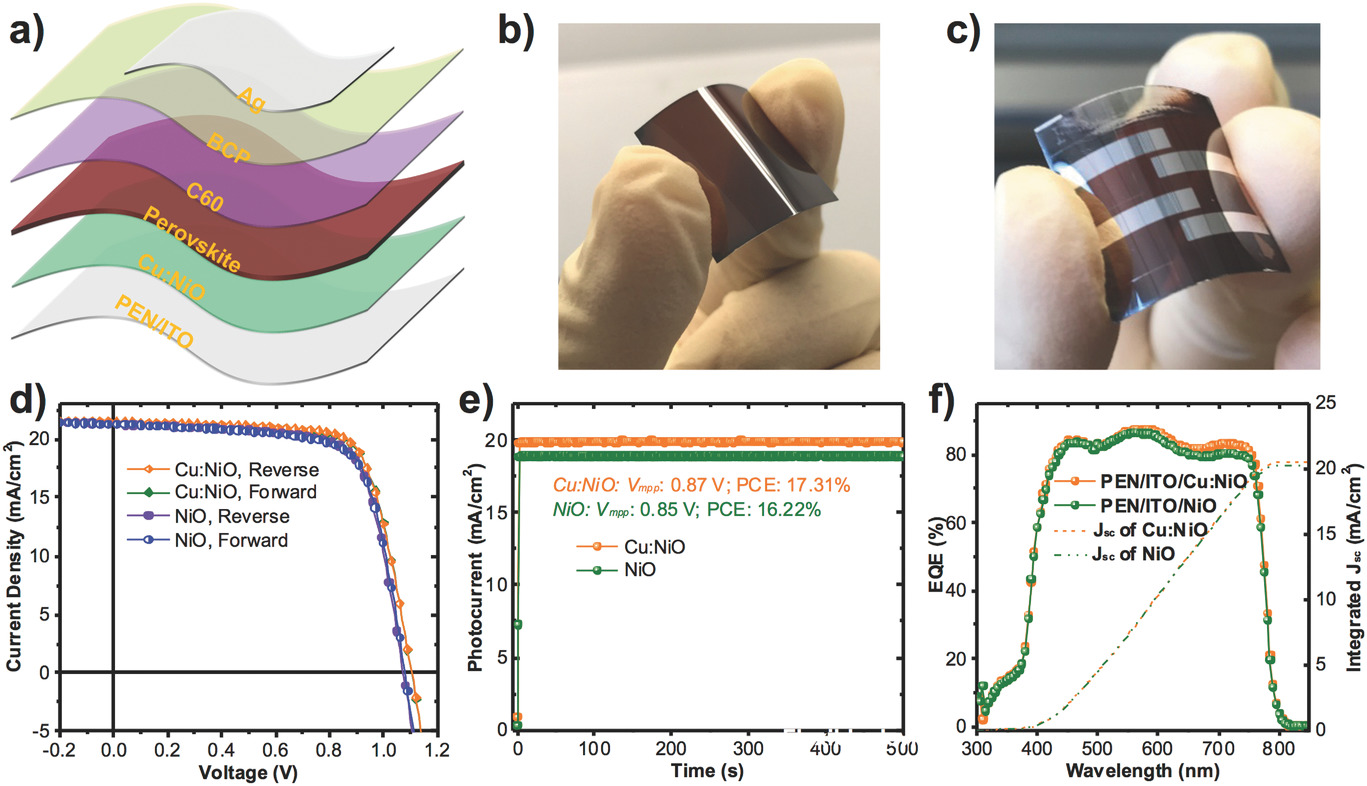Recently, the research team of Professor He Zhubing from the Department of Materials Science and Engineering has published three representative papers in the top energy materials journals Advanced Materials (influence factor: 19.79) and Advanced Energy Materials(influence factor: 16.72). The latest photovoltaic conversion efficiency in the laboratory reached 21.5%, which is one of the highest reported efficiency of inverted structural perovskite solar cells. It has comprehensively promoted the development of perovskite solar cell technology.
Very recently, Advanced Materials has outlined the latest results of Professor He’s research group on inverted perovskite solar cells. After the well-known TCNQ molecules are fluorinated, they have different numbers of fluorine atoms at the molecular, such as F4TCNQ and F6TCNNQ. Due to the strong ability of the fluorine element to seize electrons, electrons can be taken from the matrix material, and the number of holes in the matrix molecules can be increased. This effect is widely used in p-type doping of organic semiconductors. Professor He’s research group applied this doping mechanism to the doping of inorganic semiconductor nickel oxide, and innovatively proposed the concept of surface molecular doping of inorganic semiconductor nanocrystals.
Through X-ray photoelectron spectroscopy (XPS) and ultraviolet photoelectron spectroscopy (UPS), it was found that the Fermi level of nickel oxide increased from -4.63 to -5.07 eV after doping with F6TCNNQ, and the difference between the valence top (VBM) and Fermi level (EF) dropped from 0.58 to 0.29 eV. This indicates that the concentration of majority carriers (holes) in bulk after molecular doping is significantly increased.

Figure 1. XPS and UPS Data reveal the Mechanism of the Doping of F6TCNNQ on the Regulation of NiO Band Structure and the Mechanism of Decreasing the Amorphous Interfacial Energy Level of Perovskite solar cell.
It is worth noting that, for the first time, the research team used the electrostatic force scanning probe (EFM) to directly observe the electron transfer from nickel oxide to the F6TCNNQ molecule, which allowed the fluorine atoms on the molecule to gain electron ionization. Conductive atomic force scanning (c-AFM) results also show that the doped surface conductivity increases by more than one order of magnitude. Combined with the first-principles calculations, the research team for the first time confirmed the surface molecular doping mechanism of inorganic semiconductors.

Figure 2. EFM results confirm the electron transfer from NiO to F6TCNNQ.
This effect can not only greatly increase the hole concentration of NiO without changing the mobility of NiO, but also significantly increase the energy band bending of the NiO/Perovskite interface, increasing the built-in electric field as well as reducing the NiO/Perovskite energy level offset (ΔEc), which enhances the hole extraction ability of perovskite to nickel oxide. After doping, the energy level offset between nickel oxide and perovskite valence bands narrowed from 0.18 to 0.04 eV. This plays a significant role in hole transport at the anode interface of the device. Based on this, the conversion efficiency of the optimal ternary CsFAMA perovskite solar cell reached 20.86%.
The innovation of this work has been highly evaluated by the reviewers and will have important guiding significance for the interface design and regulation of solar cells, and even other organic-inorganic hybrid electronic devices. This must be the representative work of Professor He’s research group. The first author of the paper is Chen Wei , an HKU-SUSTech joint Ph.D. student. The DFT calculation was conducted by Dr. Zhou Yecheng , a research assistant professor. Other coauthors have made differing degrees of contribution to the preparation and characterization of materials and devices to the paper. Associate Professor He Zhubing and Assistant Professor Huang Li from SUSTech’s Department of Physics and Professor Aleksandra B. Djurišić from HKU’s Department of Physics are the co-corresponding authors of this paper. Professor Djurišić is the co-supervisor of Chen Wei .

Figure 3. Performance improvement of CsFAMA based device by F6TCNNQ doped NiO.
Meanwhile, Advanced Energy Materials reported online the group’s work on understanding the mechanism of copper doping in nickel oxide and its application in rigid and flexible perovskite photovoltaic cells (Adv. Energy Mater. 2018, 8, 1703519). This work was selected as the journal’s cover paper. According to the first-principles calculation, the majority of undoped nickel oxide nanocrystals originate mainly from nickel vacancies. However, its gap states are deep energy levels, 1.3-2.0 eV above the Fermi level (EF), and holes are not easily excited, affecting their charge mobility. After doping with copper ions, the gap state energy level drops to 0.7 eV over the Fermi level, and the resulting defect is a shallow energy level that contributes directly to increasing hole mobility. This result is consistent with the absorption edge of the light absorption spectrum.
We also analyzed the evolution and comparison of Ni 2p and Cu 2p peaks in detail through detailed XPS and combined the data of ultraviolet photoelectron spectroscopy (UPS) and Kelvin scanning probe (SKPM), confirming the repair of NiO deep level defects by Cu2+ and the doping mechanism of Cu+ to form shallow level defects. Hall Effect measurement results indicate that undoped NiO has a hole concentration of 5.3×1018 cm−3 and mobility of 0.12 cm2V−1s−1. After copper doping, the hole concentration is increased to 5.3×1019 cm−3. The mobility of 2.53 cm2V-1s-1 also proves that copper doping can improve the hole concentration and hole mobility of nickel oxide. Different from previous reports, the contribution of copper-doped nickel oxide was attributed to Ni3+.
This work analyzed the doping mechanism in detail in the form of full text, pointing out that the respective functions of Cu2+ and Cu+, laying a foundation for understanding the doping mechanism and strategy of NiO. In addition, the crystallized Cu: NiO nanocrystals can be coated at room temperature without any subsequent post-treatment. Therefore, the process can also be applied to a flexible polymer substrate. Based on this, the maximum efficiency for rigid small (0.1cm2) perovskite solar cell reached 20.26%, and the best rigid large (1cm2) device reached 18.07%. Furthermore, the maximum efficiency of flexible perovskite solar cells reached 17.41%. The main part of the paper was completed by the first author Wei Chen. Dr. Jing Fan from the engineering center of SUSTech made an important contribution to the DFT calculation of the work. Professor He Zhubing and Professor Aleksandra B. Djurišić are co-corresponding authors of this paper.

Figure 4. Copper-Doped Nickel Oxide Regulates the Interface Work function and Successful Production of Flexible Perovskite Solar Cells.
In addition, in October 2017, Advanced Energy Materials reported online that the research team used Cesium-doped nickel oxide for the first time to significantly enhance the performance of perovskite solar cells. With Cesium doping, the nickel oxide work function was increased from -4.89 eV to -5.11 eV, the NiO/Perovskite interfacial energy level mismatch ΔE (Band level offset) was significantly reduced. The average cell conversion efficiency also improved from 15.98% for undoped to 19.29% for Cesium doped one; the best battery efficiency reached 19.35% (Adv. Energy Mater. 2017, 7, 1700722). Due to the novelty and importance of the work, this article was selected as the back cover and was rated as one of the top ten hot papers by Adv. Energy Mater.
The above three papers were completed by the doctoral student Chen Wei as the first author. Due to his outstanding performance, Wei Chen was selected as a representative of the doctoral students of HKU-SUSTech joint Ph.D. program to give an oral presentation (title: Doped NiO for efficient inverted perovskite solar cells) at HKU-SUSTech Joint Research Symposium held by the University of Hong Kong on October 24, 2017. Since September 2016, the excellent academic performance of Ph.D. candidate Chen Wei has fully demonstrated the effectiveness of the successful cooperation between the two research groups and effectiveness of joint training Ph.D. program between SUSTech and other University.
These works were supported by the National Natural Science Foundation of China, the China-Croatia bilateral cooperation project of the Ministry of Science and Technology, the discipline layout project of the Shenzhen Branch, the key laboratory project of Shenzhen City, and the fund of the research principal.
Paper Links:
https://onlinelibrary.wiley.com/doi/abs/10.1002/adma.201800515
https://onlinelibrary.wiley.com/doi/10.1002/aenm.201703519
https://onlinelibrary.wiley.com/doi/abs/10.1002/aenm.201700722
Proofread ByChris Edwards
Photo ByDepartment of Materials Science and Engineering